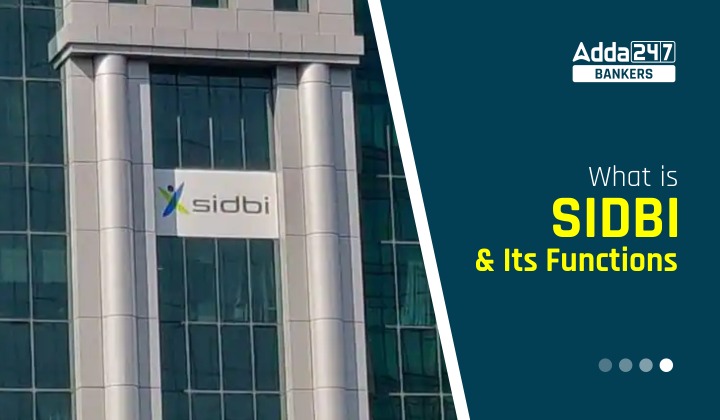The Small Industries Development Bank of India (SIDBI) was set up on 2nd April 1990 under the act of parliament. It acts as the Principal financial institution for financing MSMEs.
SIDBI Chairman: Sivasubramaniam Ramann
How SIDBI lends and helps the MSME section?
- Indirect Lending: Through banks, NBFCs, give loans to MSMEs.
- Direct lending: Bridges gaps of funding through direct lending
- Funds of funds: Startups are supported through the funds of funds channel
- Promotion and development: Through credit plus Initiatives
- Facilitator: acts as the nodal agency for Government schemes
What is the shareholding of SIDBI?
The shareholding pattern of the SIDBI :
- Government of India: 20.85%
- State bank of India: 15.65%
- LIC: 13.33 %
- NABARD: 9.36%
- Others: 40.81 %
| Download PDF of What is SIDBI & Its Functions? | |
| What is SIDBI & Its Functions? | Download PDF |
जानें SIDBI और इसके कार्य के बारे में पूरी जानकारी
Historical Journey of SIDBI
- Setup on 2nd April 1990
1992: Introduced Bills Discounting MSE Vendors
-
- Bill discounting is explained through the example: There is papad making factory owner who sold his papad to a caterer company. The caterer company gave him assurance that after 2 months it will give the payment till then it gives bill to the papad owner. But the papad owner needs money to buy the raw material so it goes to the bank and gives the bill. Bank agrees to take the bill and in exchange, it gives cash but at a discount. The bank will now get full payment from the caterer company thus getting a profit. This process is called Bill discounting.
1994: Introduced Micro-Credit Scheme
1999: SIDBI Venture Capital Limited
-
- SIDBI Venture Capital Limited (SVCL), incorporated in 1999, is an investment management company and a wholly owned subsidiary of SIDBI. SVCL has managed funds focussed on different themes including Startups/early-stage technology businesses, manufacturing SMEs, service entities, agribusinesses, financial inclusion companies, etc
2000: CGTMSE
-
- Credit Guarantee Fund Scheme (CGS) for Micro and Small Enterprises to make available collateral-free credit to the micro and small enterprise sector.
2005: SMERA (Now ACUITe) and ISTSL
-
- SMERA: SME rating agency
- India SME Technology Services Limited (ISTSL) to strengthen and accelerate the process of technological modernization in the MSME sector
2008: ISARC
-
- ISARC is the country’s first ARC supported by a large number of public sector banks and undertakings. It will strive for speedier resolution of NPAs with a focus on the MSME sector.
2010: NTREES
-
- an online bill discounting platform was being operated by NSE with SIDBI as a single financier since 2009. NTREES was based on the Reverse Factoring model followed by NAFIN in Mexico
2012: PSIG
-
- SIDBI has been implementing the “Poorest States Inclusive Growth (PSIG) Program” funded by UK Government. aimed at enhancing income and employment opportunities of the poor, especially women, in the four poorest States of Bihar, MP, Odisha, and UP by enabling the target group to participate and benefit from wider economic opportunities and growth. The program has come to a successful end in March 2020. To take the PSIG legacy forward, Swavalamban Resource Facility (SRF) has since been launched within the P&D Vertical of the Bank.
2015: MUDRA
-
- MUDRA, which stands for Micro Units Development & Refinance Agency Ltd., is a financial institution set up by the Government of India for the development and refinancing of micro units enterprises
2016: RXIL TReDS and Standupmitra Platform
-
- Receivables Exchange of India Ltd (RXIL) was incorporated on February 25, 2016 as a joint venture between the Small Industries Development Bank of India (SIDBI) – the apex financial institution for the promotion and financing of MSMEs in India, and the National Stock Exchange of India Limited (NSE) – premier stock exchange in India. RXIL operates the Trade Receivables Discounting System (TReDS) Platform as per the TReDS guideline issued by the Reserve Bank of India (RBI) on December 3, 2014. It is the first entity to receive approval from RBI on December 01, 2016, to launch India’s First TReDS Exchange.
- Standup mitra platform to facilitate Standup India scheme
2017: Udyamimitra Portal
-
- Udyamimitra Portal is an enabling platform, aims to provide ‘End to End’ solutions not only for credit delivery but also for the host of credit plus services by way of handholding support, application tracking, multiple interface with stakeholders (i.e. lenders, service providers, applicants
2018: Launched PSBloansin59minutes, MSME Pulse, Crisidex and Swavalamban
- 2019: Microfinance pulse
- 2020: Launched Fintech Pulse and Industry Spotlight
Other posts




 GA Capsule for SBI Clerk Mains 2025, Dow...
GA Capsule for SBI Clerk Mains 2025, Dow...
 The Hindu Review October 2022: Download ...
The Hindu Review October 2022: Download ...
 IB ACIO 2025 Notification PDF Out for 37...
IB ACIO 2025 Notification PDF Out for 37...


